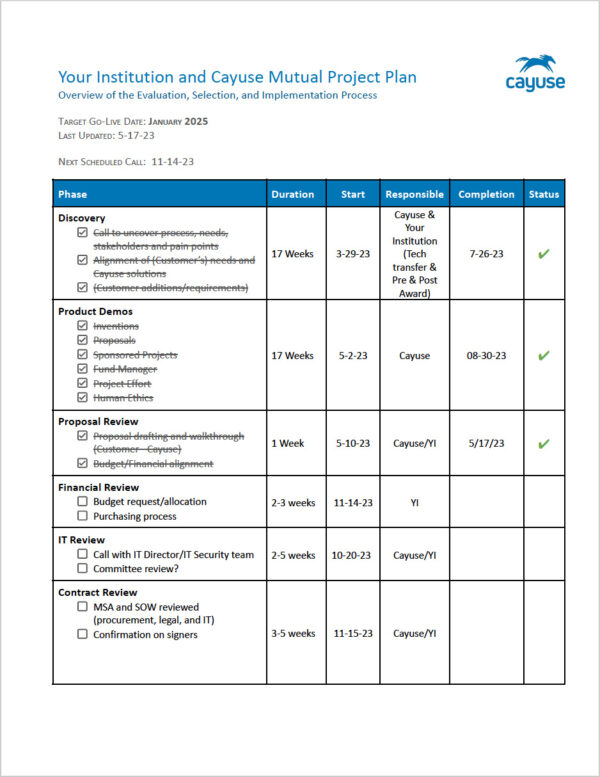At Cayuse, we understand that investing in a new eRA software solution is a significant undertaking, regardless of your institution’s size. The process involves collaboration from multiple teams within your organization—each with its own priorities and objectives—across several stages that span multiple months. It can be a lot to juggle.
When looking at reasons why software implementations go awry, a lack of expectation-setting is often one of the most prominent factors. That’s why we’ve developed our Mutual Project Plan, a comprehensive action list and project outline designed to guide your team through the purchasing process and beyond. With over 1,000 implementations under our belt, we’ve found that outlining and working through a clear plan together fosters a shared sense of ownership and understanding, keeps everyone accountable, and ultimately contributes to the long-term success of each implementation. 
What is the Mutual Project Plan?
The Mutual Project Plan isn’t just a document; it’s the foundation of a partnership. From the earliest stages of discovery to finalizing the rollout of the last application, the plan is tailored to suit your organization’s specific needs and desired pace. Collaborating at every step ensures you get the technology platform you want on the timeline you need.
Navigating the purchasing process together
While every software deployment is unique to the institution, we’ve learned a lot over the course of over 1,000 implementations. The timelines listed below are averages and may be shorter or longer for your organization, depending on your desired go-live dates and the bandwidth of everyone involved. (More on this below.) We share these estimates as a loose guide to help guide your expectation-setting as you navigate the software purchasing process.
Phase 1: Discovery (1-2 weeks)
Every buying journey begins with an in-depth exploration of your processes and the solutions that deliver the most value. This stage sets the foundation, enabling us to tailor a product demo that answers your questions and reflects the benefits Cayuse can bring to your institution.
Phase 2: Product Demos (4-6 weeks)
Next, we walk you through a Cayuse demonstration, allowing all stakeholders to see firsthand how well our applications align with your institutional requirements. If the average timeline seems long, it’s because we allow time to accommodate all teams and users who want to see an early demo of the eRA solution they might be using. As with most stages, this timeline can be longer or shorter depending on the number of stakeholders and their availability.
Phase 3 + 4: Proposal Review (2-3 weeks) + Implementation Overview (2-3 weeks)
Once we’ve determined that Cayuse can effectively address your pain points and deliver the value you need, we move to the proposal and implementation overview. At this stage, we share pricing and discuss more specific onboarding timelines, ensuring complete alignment between our team and yours.
Phase 5: Financial Review (2-5 weeks)
This is the stage where the software budget is requested, allocated, and approved. Buyers at emerging institutions may never have worked with their procurement, IT, or legal teams before, so our team is happy to take a leading role wherever helpful.
Phase 6: IT Review (3-5 weeks)
The next two stages can easily become bottlenecks, so we prepare for them well in advance. For example, the IT review phase typically takes about 3-5 weeks—but at large institutions with a significant IT backlog, the process can take far longer. For that reason, we suggest involving IT as early as possible. Early access to documentation such as your standard vendor questionnaire can help us proactively engage with IT’s security screenings and committee review, helping prevent bottlenecks or dead time in the schedule.
Phase 7: Contract Review + Execution (3-5 days)
Legal review can also be time-consuming, especially if your legal team is already working through a long list of contracts. To that end, we recommend sending our Master Service Agreement (MSA) to Legal while we are still working through some of the earlier phases, allowing them time to raise any red flags well before the final days of the process.
Overcoming common stumbling blocks
If you’re looking ahead to your first major software purchase—or your first one in a while—don’t worry. Our experienced team has worked through hundreds of implementations, and we’re here to help you avoid common pitfalls and achieve your institutional objectives with ease. Here are a few examples of how we work together with our clients to ensure implementation success:
- Consultative approach: We understand that different institutions have varying levels of experience with purchasing software, so we offer guidance at each step. This is particularly impactful for emerging institutions, which might have limited experience with the complexities of purchasing processes. We use our depth of experience to consult with your team and pinpoint bottlenecks before they turn into problems.
- Realistic goal-setting: While ambitious goals are laudable, it’s also essential to establish realistic timelines that preserve your team’s sanity. We’ll help level-set expectations, confirm realistic timelines, and suggest a rollout plan that achieves your objectives without overwhelming your users.
- Stakeholder engagement: One common challenge with software deployments is ensuring that all users are engaged and on the same page about what’s expected. The Mutual Project Plan provides clarity by clearly outlining roles and responsibilities, preventing delays and misunderstandings. The plan also offers the satisfaction of checking completed items off a list and getting a clear picture of what comes next—and who doesn’t love that?
- Facilitating conversations: Our team will help you identify the right people to involve in every phase and support your outreach to stakeholders outside your team. If you aren’t comfortable having those conversations directly, feel free to put Cayuse in touch. We’re always happy to help facilitate those conversations on your behalf.
- Regular touch-points: As we work through the Mutual Project Plan, we encourage weekly reviews and updates to keep everyone abreast of progress. At these weekly touch-points, we can track ongoing developments and adjust plans as needed, ensuring the deployment stays on track.
Conclusion
At Cayuse, we bring our vast experience to bear at every step, helping to ensure a smooth transition to your new eRA software. Our deeply collaborative process ensures that we help your institution modernize and scale, leveraging our expertise to guide you every step of the way. Choosing Cayuse means opting for a partner as invested in your success as you are. Starting with the Mutual Project Plan, we promise a collaborative, efficient, and transparent process that considers your institution’s unique needs and goals.


